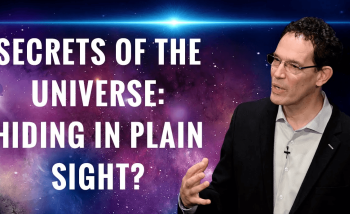The team’s research, culminating in a paper just published in Physical Review Letters, reached a nearly century-old cosmological equation. It’s a result that might seem, at first glance, somewhat unremarkable.
“If you showed the last equation in our paper to a cosmologist, he wouldn’t be too impressed because it’s the most basic equation of cosmology,” said Gielen. “You’d find it on page one of a cosmology textbook.”
But that equation – a description of an empty universe first put forward 89 years ago by pioneering physicist Alexander Friedmann – is exactly what the researchers were hoping for. The equation, in this context, is remarkable because of how they reached it.
Coming up with the fundamental equation through a different avenue of investigation – the avenue of quantum gravity – is an achievement with important implications.
Research in quantum gravity seeks to unify the physics of the big, as described by Einstein’s general relativity, with the physics of the tiny, which is described by quantum mechanics. Both theories have decades of experimental verification, but they don’t play nicely with each other; a new theory that unifies them is among the grandest goals of contemporary physics.
Research in ‘background-independent’ quantum gravity, like the work done by Gielen and collaborators, is one of several approaches that aim to unify these pillars of physics. So when Gielen and collaborators arrived at a foundational equation of cosmology through what’s called the ‘group field theory’ approach to quantum gravity, they were justifiably “quite excited.”
By reaching the Friedmann equation that describes a bare-bones, homogeneous model of the universe (think of it like a blackboard with nothing written on it), the researchers demonstrated the potential for compatibility between quantum mechanics and general relativity.
Results of this sort could lead to a better understanding of the beginnings of the universe, since the big bang exemplifies an instance of the apparent incompatibility of general relativity and quantum mechanics.
The paper in Physical Review Letters is the result of a year’s worth of collaborative research in Canada and Germany (and plenty of Skype chats). Gielen teamed with Daniele Oriti and Lorenzo Sindoni, both of the Max Planck Institute for Gravitational Physics (Albert Einstein Institute), where Gielen held a postdoctoral position before joining Perimeter in January 2012.
Their finding opens the door to follow-up research – already under way by Gielen and collaborators – applying their approach to more complex models of the universe, taking into account factors like matter and perturbations.
That is, having demonstrated a principle with a theoretical ‘empty’ universe, they will now fill their universe with stuff and see if their predictions hold true.
“The real universe isn’t exactly homogeneous – it has structure, galaxies, planets, everything,” Gielen explained. “The standard theories of cosmology give us good explanations for these, so we need to explain things like that within the quantum gravity framework.”
The result outlined in Physical Review Letters represents a significant step in that direction, and a tantalizing glimpse at the future of quantum gravity research.
“The great potential that this has is to give us a much clearer connection between quantum gravity and cosmology,” Gielen said. “These are two big research areas at Perimeter. With them, we can really study things like the big bang and understand what’s going on.”
About PI
Perimeter Institute is the world’s largest research hub devoted to theoretical physics. The independent Institute was founded in 1999 to foster breakthroughs in the fundamental understanding of our universe, from the smallest particles to the entire cosmos. Research at Perimeter is motivated by the understanding that fundamental science advances human knowledge and catalyzes innovation, and that today’s theoretical physics is tomorrow’s technology. Located in the Region of Waterloo, the not-for-profit Institute is a unique public-private endeavour, including the Governments of Ontario and Canada, that enables cutting-edge research, trains the next generation of scientific pioneers, and shares the power of physics through award-winning educational outreach and public engagement.
You might be interested in


Spiralling light from M87’s supermassive black hole reveals strong magnetic fields
November 8, 2023
